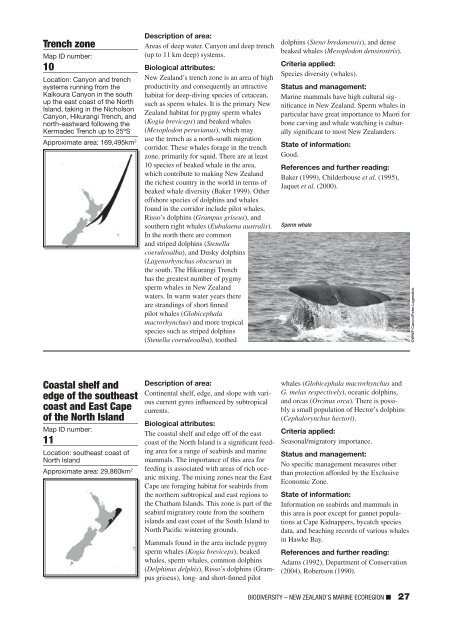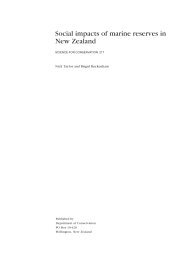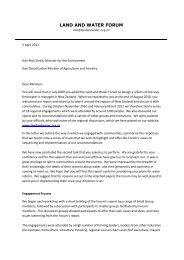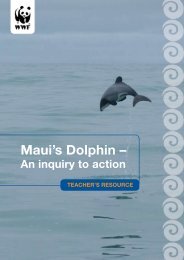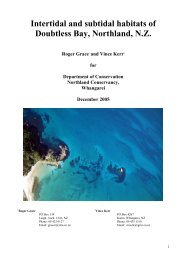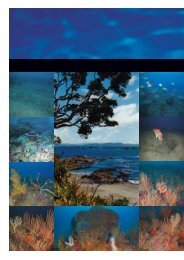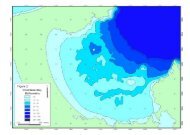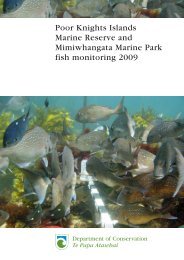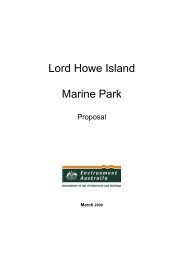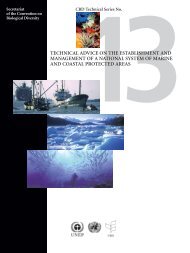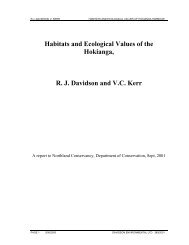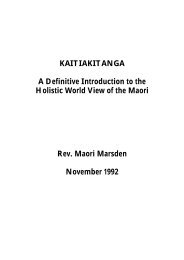WWF Shining a spotlight on the biodiversity of ... - MarineNZ.org.nz
WWF Shining a spotlight on the biodiversity of ... - MarineNZ.org.nz
WWF Shining a spotlight on the biodiversity of ... - MarineNZ.org.nz
You also want an ePaper? Increase the reach of your titles
YUMPU automatically turns print PDFs into web optimized ePapers that Google loves.
Trench z<strong>on</strong>e<br />
Map ID number:<br />
10<br />
Locati<strong>on</strong>: Cany<strong>on</strong> and trench<br />
systems running from <strong>the</strong><br />
Kaikoura Cany<strong>on</strong> in <strong>the</strong> south<br />
up <strong>the</strong> east coast <strong>of</strong> <strong>the</strong> North<br />
Island, taking in <strong>the</strong> Nichols<strong>on</strong><br />
Cany<strong>on</strong>, Hikurangi Trench, and<br />
north-eastward following <strong>the</strong><br />
Kermadec Trench up to 25ºS<br />
Approximate area: 169,495km 2<br />
Descripti<strong>on</strong> <strong>of</strong> area:<br />
Areas <strong>of</strong> deep water. Cany<strong>on</strong> and deep trench<br />
(up to 11 km deep) systems.<br />
Biological attributes:<br />
New Zealand’s trench z<strong>on</strong>e is an area <strong>of</strong> high<br />
productivity and c<strong>on</strong>sequently an attractive<br />
habitat for deep-diving species <strong>of</strong> cetacean,<br />
such as sperm whales. It is <strong>the</strong> primary New<br />
Zealand habitat for pygmy sperm whales<br />
(Kogia breviceps) and beaked whales<br />
(Mesoplod<strong>on</strong> peruvianus), which may<br />
use <strong>the</strong> trench as a north-south migrati<strong>on</strong><br />
corridor. These whales forage in <strong>the</strong> trench<br />
z<strong>on</strong>e, primarily for squid. There are at least<br />
10 species <strong>of</strong> beaked whale in <strong>the</strong> area,<br />
which c<strong>on</strong>tribute to making New Zealand<br />
<strong>the</strong> richest country in <strong>the</strong> world in terms <strong>of</strong><br />
beaked whale diversity (Baker 1999). O<strong>the</strong>r<br />
<strong>of</strong>fshore species <strong>of</strong> dolphins and whales<br />
found in <strong>the</strong> corridor include pilot whales,<br />
Risso’s dolphins (Grampus griseus), and<br />
sou<strong>the</strong>rn right whales (Eubalaena australis).<br />
In <strong>the</strong> north <strong>the</strong>re are comm<strong>on</strong><br />
and striped dolphins (Stenella<br />
coeruleoalba), and Dusky dolphins<br />
(Lagenorhynchus obscurus) in<br />
<strong>the</strong> south. The Hikurangi Trench<br />
has <strong>the</strong> greatest number <strong>of</strong> pygmy<br />
sperm whales in New Zealand<br />
waters. In warm water years <strong>the</strong>re<br />
are strandings <strong>of</strong> short finned<br />
pilot whales (Globicephala<br />
macrorhynchus) and more tropical<br />
species such as striped dolphins<br />
(Stenella coeruleoalba), too<strong>the</strong>d<br />
dolphins (Steno bredanensis), and dense<br />
beaked whales (Mesoplod<strong>on</strong> densirostris).<br />
Criteria applied:<br />
Species diversity (whales).<br />
Status and management:<br />
Marine mammals have high cultural significance<br />
in New Zealand. Sperm whales in<br />
particular have great importance to Maori for<br />
b<strong>on</strong>e carving and whale watching is culturally<br />
significant to most New Zealanders.<br />
State <strong>of</strong> informati<strong>on</strong>:<br />
Good.<br />
References and fur<strong>the</strong>r reading:<br />
Baker (1999), Childerhouse et al. (1995),<br />
Jaquet et al. (2000).<br />
Sperm whale<br />
©<str<strong>on</strong>g>WWF</str<strong>on</strong>g>-Can<strong>on</strong>/Peter Lagendick<br />
Coastal shelf and<br />
edge <strong>of</strong> <strong>the</strong> sou<strong>the</strong>ast<br />
coast and East Cape<br />
<strong>of</strong> <strong>the</strong> North Island<br />
Map ID number:<br />
11<br />
Locati<strong>on</strong>: sou<strong>the</strong>ast coast <strong>of</strong><br />
North Island<br />
Approximate area: 29,860km 2<br />
Descripti<strong>on</strong> <strong>of</strong> area:<br />
C<strong>on</strong>tinental shelf, edge, and slope with various<br />
current gyres influenced by subtropical<br />
currents.<br />
Biological attributes:<br />
The coastal shelf and edge <strong>of</strong>f <strong>of</strong> <strong>the</strong> east<br />
coast <strong>of</strong> <strong>the</strong> North Island is a significant feeding<br />
area for a range <strong>of</strong> seabirds and marine<br />
mammals. The importance <strong>of</strong> this area for<br />
feeding is associated with areas <strong>of</strong> rich oceanic<br />
mixing. The mixing z<strong>on</strong>es near <strong>the</strong> East<br />
Cape are foraging habitat for seabirds from<br />
<strong>the</strong> nor<strong>the</strong>rn subtropical and east regi<strong>on</strong>s to<br />
<strong>the</strong> Chatham Islands. This z<strong>on</strong>e is part <strong>of</strong> <strong>the</strong><br />
seabird migratory route from <strong>the</strong> sou<strong>the</strong>rn<br />
islands and east coast <strong>of</strong> <strong>the</strong> South Island to<br />
North Pacific wintering grounds.<br />
Mammals found in <strong>the</strong> area include pygmy<br />
sperm whales (Kogia breviceps), beaked<br />
whales, sperm whales, comm<strong>on</strong> dolphins<br />
(Delphinus delphis), Risso’s dolphins (Grampus<br />
griseus), l<strong>on</strong>g- and short-finned pilot<br />
whales (Globicephala macrorhynchus and<br />
G. melas respectively), oceanic dolphins,<br />
and orcas (Orcinus orca). There is possibly<br />
a small populati<strong>on</strong> <strong>of</strong> Hector’s dolphins<br />
(Cephalorynchus hectori).<br />
Criteria applied:<br />
Seas<strong>on</strong>al/migratory importance.<br />
Status and management:<br />
No specific management measures o<strong>the</strong>r<br />
than protecti<strong>on</strong> afforded by <strong>the</strong> Exclusive<br />
Ec<strong>on</strong>omic Z<strong>on</strong>e.<br />
State <strong>of</strong> informati<strong>on</strong>:<br />
Informati<strong>on</strong> <strong>on</strong> seabirds and mammals in<br />
this area is poor except for gannet populati<strong>on</strong>s<br />
at Cape Kidnappers, bycatch species<br />
data, and beaching records <strong>of</strong> various whales<br />
in Hawke Bay.<br />
References and fur<strong>the</strong>r reading:<br />
Adams (1992), Department <strong>of</strong> C<strong>on</strong>servati<strong>on</strong><br />
(2004), Roberts<strong>on</strong> (1990).<br />
BIODIVERSITY – NEW ZEALAND’S MARINE ECOREGION ■ 27


